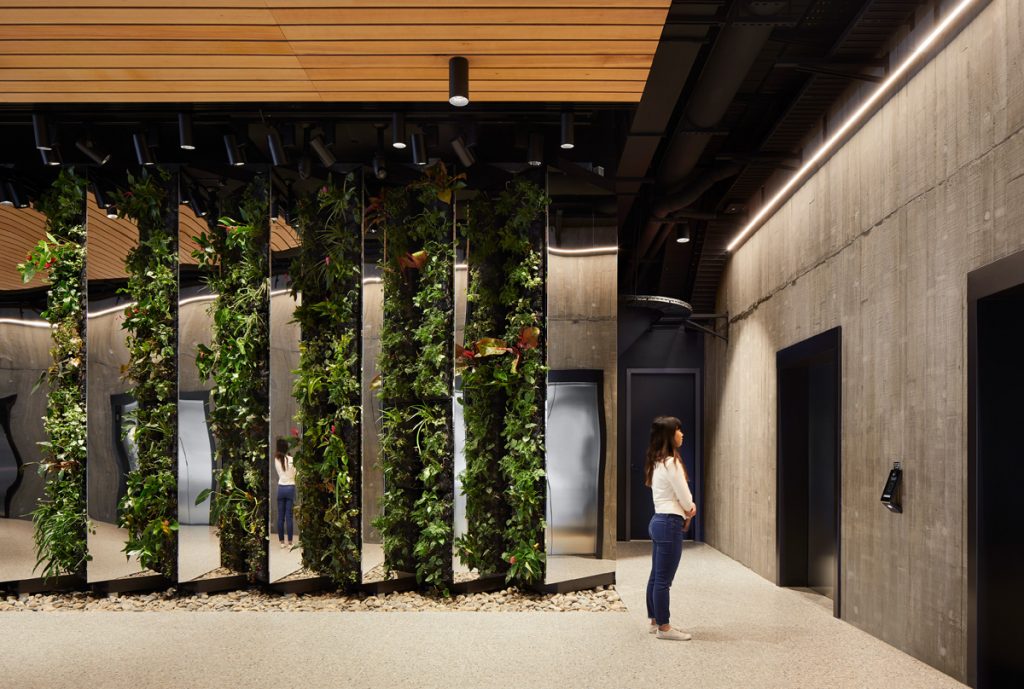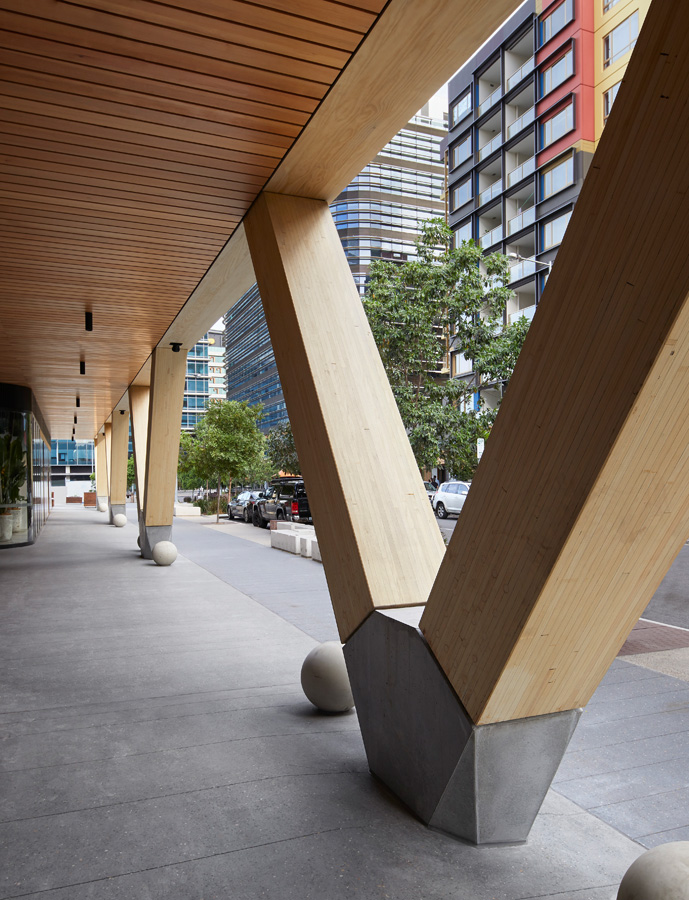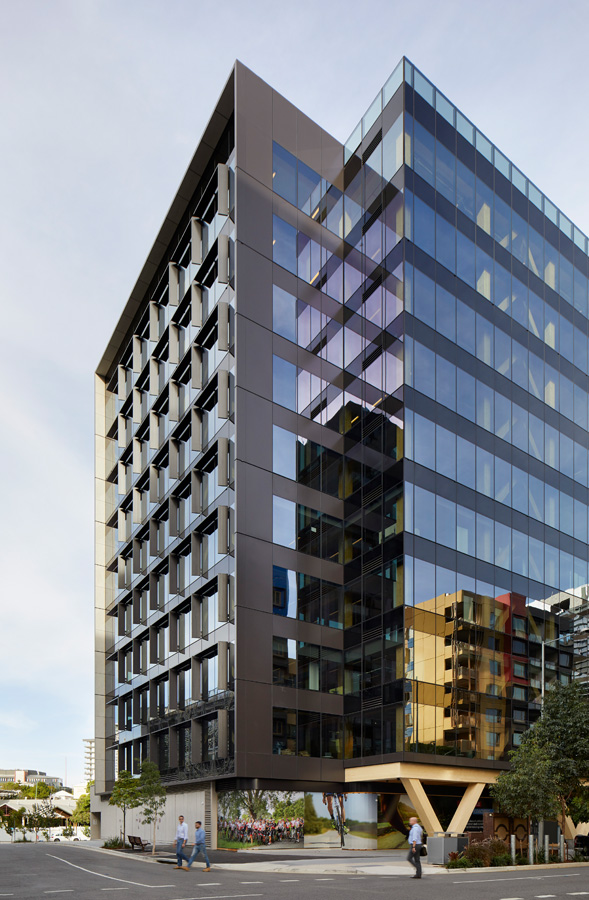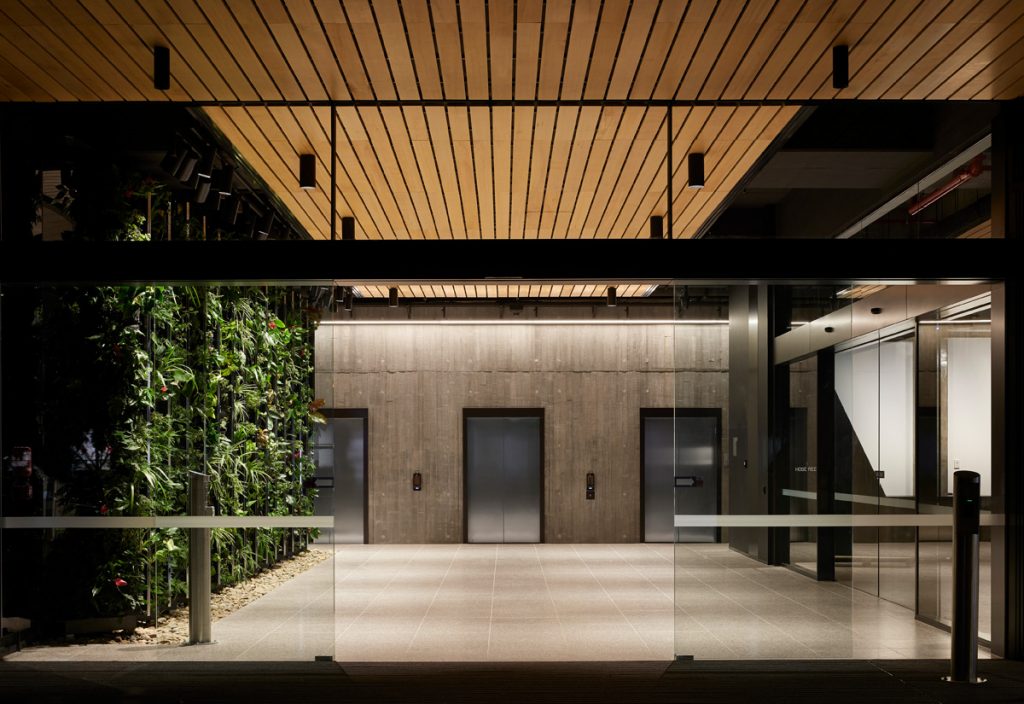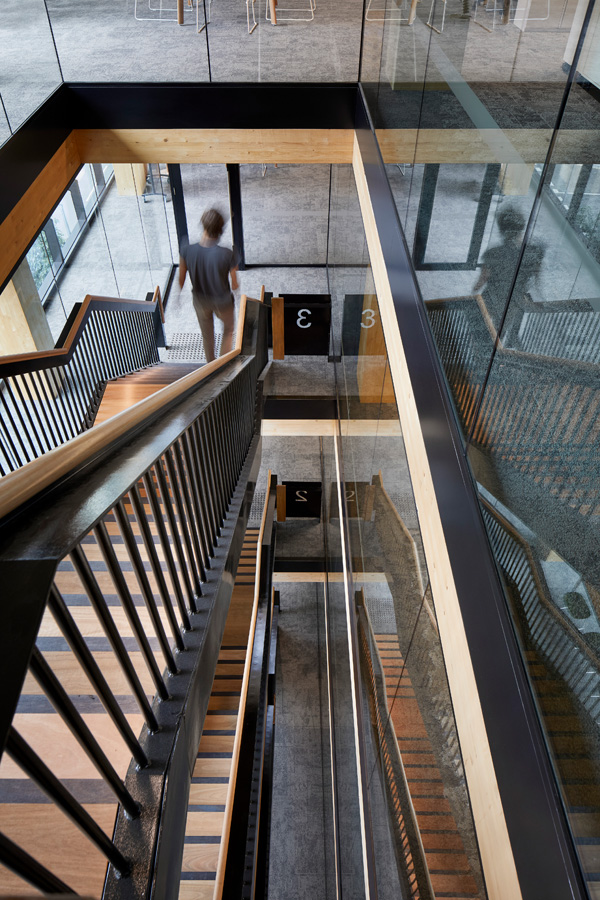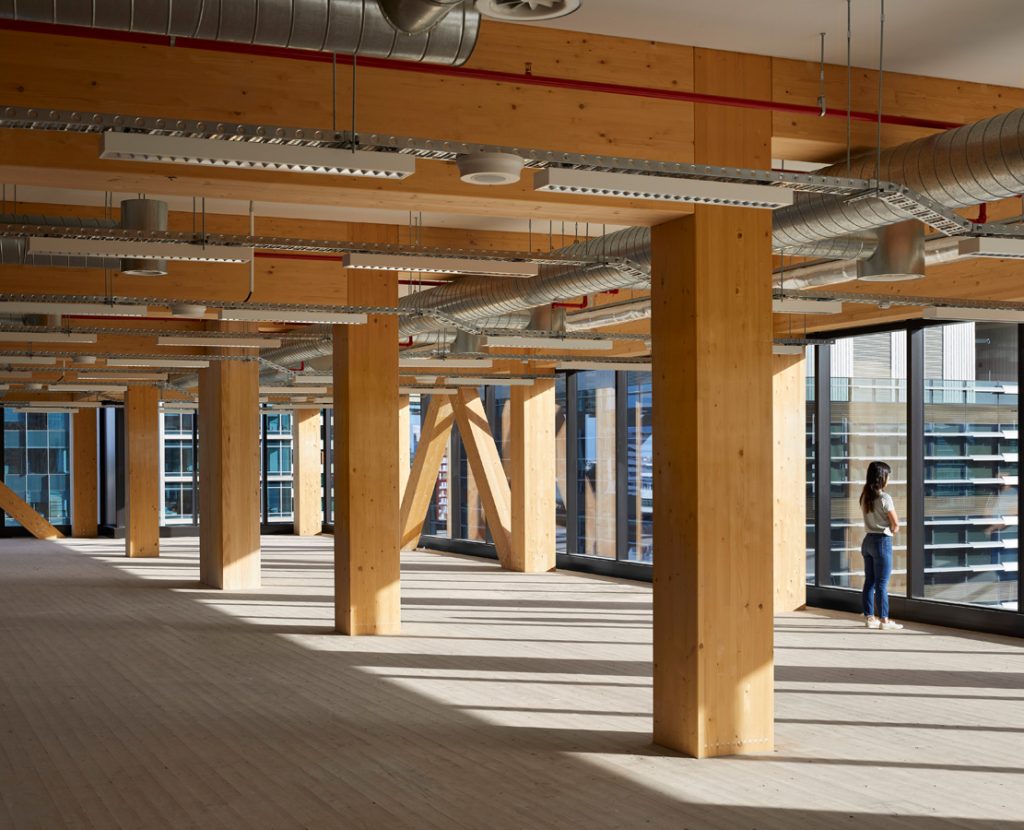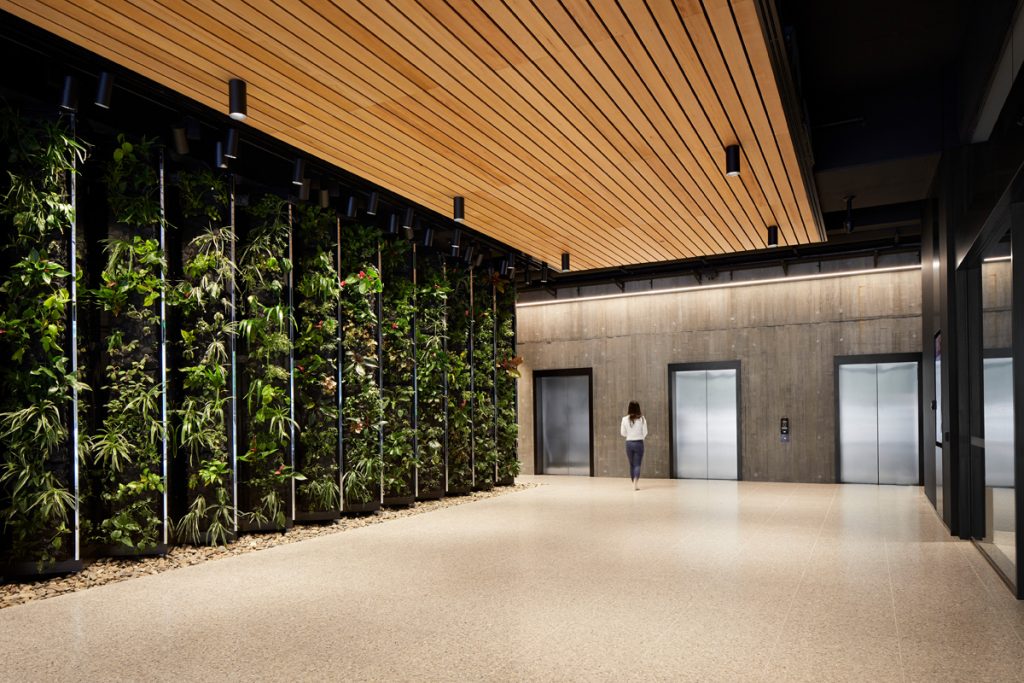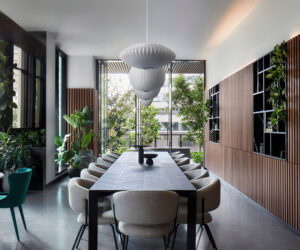Australia’s tallest timber building completed
Lendlease’s 25 King in Brisbane by Australian architecture and interiors firm Bates Smart, takes Australia to the forefront of innovation in timber construction design.
The 10-storey, 45-metre tall open-plan office complex – the tallest timber structure in Australia – establishes new frontiers in the design of commercial buildings, bringing a clear expression of its exposed timber structure to the building’s transparent envelope and promoting a warmer, more natural workplace environment of the future.
25 King heralds a move away from steel and concrete towards the more sustainable resource of timber. Acknowledging historic principles of timber construction, the structure combines Glulam (glued laminated timber) and CLT (cross laminated timber) – embodying Bates Smart’s research into engineered timber technology and typologies to meet modern-day demands of function and sustainability. The engineered timber structure is substituted for concrete or steel but with a significantly lower carbon footprint, in effect acting as a carbon sink.1 Unlike steel construction,CLT does not require additional fire protection measures but inherits its fire resistance naturally by being able to retain its structural integrity in the event of fire.2
Combining honest expression of structure and materials with a sustainable ideology, the building is part of the 22-hectare Brisbane Showgrounds regeneration district. It was commissioned by international property and infrastructure group Lendlease for Impact Investment Group and will be anchored by global engineering firm Aurecon.
Philip Vivian, Bates Smart Director, comments: “Each time an engineered timber project completes, architects learn more about CLT’s potential as a new building material and how we can work and innovate with it on all types of buildings. This building marks a genuine commitment to CLT from the industry. It’s exciting to see the ideas take hold and evolve across the globe, and we’re happy to contribute with the lessons we’ve learned on 25 King.”
Raised on massive exposed timber v-columns and with the south facade expressed as a ‘verandah’ of engineered timber, 25 King covertly references the wooden vernacular of the ‘Queenslander’ building type as well as nodding to the historic pavilions of the Showgrounds district. Nine levels of open-plan office space, serviced via a north-facing side core, are balanced above a ground floor shaded timber colonnade hosting cafés and restaurants, which open up the building as part of the public realm.
Internally, the use of an exposed CLT timber slab for ceiling soffits has eradicated the need for a suspended ceiling system, opening up the floorplates to a lofty ceiling height and creating a warmer interior aesthetic with softer surfaces and acoustics, which maximise the psychological benefits associated with timber in interiors.3
Philip Vivian, Bates Smart Director, said: “25 King reflects a turn towards making buildings and spaces that are warm and inviting. We know that people want to connect to nature, and using timber on the exterior and interior of buildings helps complete the connection, making people feel more at ease within the built environment.”
The structure and highly flexible floorplates evolved from extensive research and testing of engineered timber typologies. It employs a six x eight metre grid in terms of both optimum distribution of columns and ceiling heights, which are determined by the span of the Glulam ceiling beams (building services ducts run parallel without the need to penetrate). The arrangement of columns creates a more intimate open-plan scale while allowing flexible and efficient spatial organisation of office floors. It also minimises the size of the exposed Glulam columns, allowing them to register almost as joinery rather than structural elements.
25 King’s innovations in rapid modular CLT construction provide significant economic and environmental benefits for clients. The extensive pre-construction design process and off-site fabrication led to a significantly shortened and cleaner on-site construction programme with minimal waste. The building was constructed in 18 months, with the facade envelope following structure in a floor-by-floor sequence.
The building is projected to achieve a 6 Star Green Star Design and As Built v1.14 and a NABERS Energy 5 Star5 rating as well as a LEED Platinum rating. In addition to employing sustainably sourced timber, 25 King maximises natural daylighting to the floorplates through its south-facing facade while incorporating sunshades of folded aluminium on other facades to reduce heat build-up. Further sustainable features include rainwater harvesting, energy efficient lighting, optimised air-conditioning and a green wall in the entrance lobby.
Bates Smart is currently exploring the potential of CLT as a new lightweight building material with major carbon benefits in a range of contexts and typologies across four states including: a 10-storey curved engineered timber ‘tower extension’ to an existing low-rise building in Melbourne’s Southbank; two five-level engineered timber buildings in Canberra, totalling 10 200-square-metres; and a six-level commercial building in Cremorne.
25 King project facts:
- Ten new levels of CLT construction
- The building’s total area is 14 921-square-metres (NLA), with each office floor providing 1588-square-metres (NLA)
- Each cubic metre of CLT stores approximately 900kg of CO2 and the manufacturing process contributes to about 350 kilograms of CO2 emissions. Therefore, the net carbon offset is 550 kilograms of CO2 per cubic metre.
- 25 King was constructed in 18 months – the shorter construction time is due to the quantum of prefabrication off-site
- On-site wastage is reduced due to the fact that all slabs and walls are pre-fabricated and all openings required for services were set out prior to manufacture. Good potential for disassembly and reuse. Lower life cycle assessment impacts compared to conventional concrete and steel
- CLT is 20 per cent lighter than concrete
Footnotes
- ‘For every dry tonne of timber produced, 1.8 tonnes of carbon dioxide is taken from the atmosphere.’ (Timber NSW) [and equivalent data]
- If CLT is exposed to fire, a process known as “pyrolysis” (whereby gas emissions from combustible components in the wood burst into flame) occurs, leaving a charring area behind it. This char layer protects the internal CLT layers which have not yet been exposed to fire thus retaining the effective structure.The process of pyrolysis and the behaviour of wood can actually be predicted (unlike steel or concrete constructions). By contrast, steel constructions, for example, require additional fire protection measures.
- Recent research by Pollinate for Wood Solutions has quantified the benefits of timber in interior spaces in terms of wellbeing and productivity, Workplaces: Wellness + Wood = Productivity
- The Green Building Council of Australia’s assessment of the sustainability outcomes from the design and construction of new buildings or major refurbishments, across nine holistic impact categories.
- National Australian Built Environment Rating System to measure a building’s energy efficiency, carbon emissions, as well as the water consumed, the waste produced and compare it to similar buildings.


